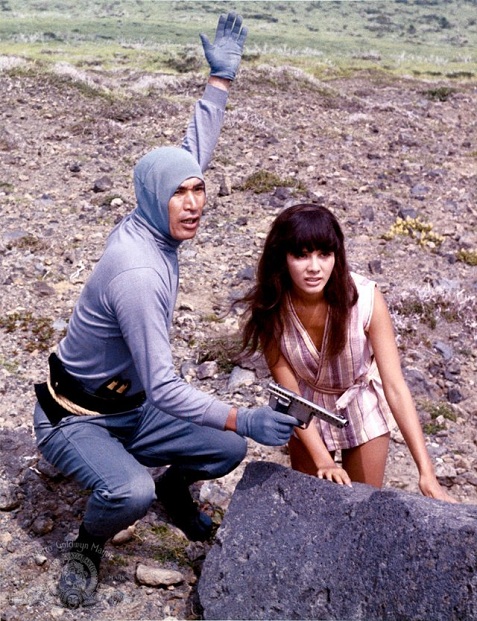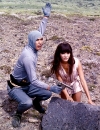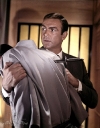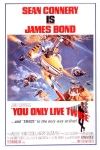007 One by One: ‘You Only Live Twice’
Bullz-Eye is celebrating the 50th anniversary of the first James Bond film with look back at every Bond movie, 007 One by One, along with a series of features about the Bond franchise, all laid out in our James Bond Fan Hub.
As the worldwide spy craze peaks, the James Bond series settles in for the long, tongue-in-cheek haul with this often maligned but very enjoyable entry, introducing the world to both ninjas and the original Dr. Evil. It also might have been the final appearance of Sean Connery as 007, except that it wasn’t.
“You Only Live Twice” (1967)
The Plot
A United States space capsule is hijacked, killing one astronaut. Naturally, the Americans assume the Soviets are at fault and world war seems a real possibility. There’s only one thing for the level-headed English to do: Stage James Bond’s death and send him on an undercover mission to Japan to expose SPECTRE head Ernst Stavro Blofeld’s plot to dominate the world by partially destroying it.
The Backstory
With enormous success comes enormous pressures and change was very definitely in the air as “You Only Live Twice” began production. Now one of the world’s most bankable stars after the mega-success of “Thunderball,” Sean Connery was contractually on board for only one more film and starting to be seriously fed up with all the 007 insanity.
Behind the camera, original Bond director Terrence Young had had his fill and “Goldfinger” helmer Guy Hamilton was unavailable. Editor and second unit director Peter Hunt, who had been instrumental in the series’ creative success, badly wanted to helm the project, but producers Albert “Cubby” Broccoli and Harry Saltzman apparently weren’t ready for a first timer for Bond #5. Therefore, a new recruit was sought out to join the small fraternity of James Bond directors.
An old hand at period pieces and war films, Lewis Gilbert was hot off an Oscar nomination for a classic-to-be about a compulsive womanizer who could give Bond a run for his money. “Alfie” starred Connery’s good friend, fellow movie spy, and now award-winning box office rival, Michael Caine.
Lewis Gilbert also brought along one of the very few directors of photography who could have reasonably stepped into the very big shoes of series regular Ted Moore. Freddie Young had won the first of his four Oscars a couple of years prior for David Lean’s visually stunning 1963 70mm masterpiece, “Lawrence of Arabia.” For the sake of keeping things consistent, all the other key collaborators, were back on board in their regular roles, i.e., composer John Barry, credit designer Maurice Binder, and production designer Ken Adam. For once, they’d all have a nice budget to play with, too.
The script, however, was an issue. The novel “You Only Live Twice,” was the last Bond book published in Ian Fleming’s lifetime and the story was problematic for more than one reason. For starters, it was actually the third and final installment in what literary Bond fans call “the Blofeld Trilogy.” EON’s original intent had been to film the books in their original order. That way Blofeld, who had been teased as a character starting in “Dr. No,” would get his long-delayed onscreen introduction in “On Her Majesty’s Secret Service” and finally suffer James Bond’s revenge in the follow-up, “You Only Live Twice.” Unfortunately, logistics made the ski chalet setting of “Majesty” impractical for the summer release EON and United Artists had their hearts set on.
The other problem was that the plot of Ian Fleming’s novel, which involved Blofeld setting up a lavish sanitarium for wealthy suicides, just didn’t seem to be the stuff of a James Bond movie. It also ended with Bond fathering a child with Kissy Suzuki. Only a few elements from the book would remain in the finished movie, most notably the Japanese setting, love interest Kissy, and friendly spy boss Tiger Tanaka.
There was also a problem with finding a writer. Richard Maibum, who had worked on every Bond up to this point, was deemed unavailable. A rumored screenplay by renowned author Kingsley Amis had been reportedly dismissed. Another script was commissioned by writer Harold Jack Bloom, but little of his work would remain in the finished film.
The final choice of screenwriter turned out to be an interesting one. Decades after his death, Roald Dahl remains one of the world’s most popular children’s writers with such film-friendly classics as “Charlie and the Chocolate Factory,” “Fantastic Mr. Fox,” “The Witches,” “Matilda,” and “James and the Giant Peach” all too his credit. He might have seemed a far likelier choice for writing an adaptation of Ian Fleming’s children’s book, “Chitty Chitty Bang-Bang,” the gig that was apparently keeping Richard Maibum busy. Nevertheless, Dahl had written his share of adult thrillers and had actually performed wartime espionage and been friends with Fleming. Scads of 007-inspired spy spoofs were upping the humor ante and this would be a somewhat more tongue-in-cheek Bond. Dahl’s dark sense of humor would be a plus.
The main thrust of the film’s new plot was apparently invented by Cubby Broccoli, however. Upon seeing a dormant volcano while scouting locations, he came up with the idea of using it as a giant villain’s lair. With the U.S.-Soviet space race at full swing, the Russian-Chinese split a topical news item, and terrorism on the rise, the idea of SPECTRE hijacking spacecrafts in order to start a world war on behalf of Red Chinese clients seemed like a natural.
The Bond Girls (Rule of 3 + 1)
Once again, 007 does the espionage nasty with three beautiful women on his Japan adventure. Shockingly, however, the movie’s main love interest is not one of them.
Ling (Tsai Chow) — This lovely lady of Hong Kong engages in mildly racist pillow talk with Bond and then reveals herself to be an accomplice in the spy’s elaborately faked death. Though her part is small, actress Tsai Chow was already a recording artists and a major star of the London stage in “South Pacific” and “The World of Suzie Wong.” Her very long film career would include parts in “The Joy Luck Club,” “Memoirs of a Geisha,” and the 2006 Bond reboot, “Casino Royale.”
Helga Brandt (Karen Dor) — The latest Bond villainess with preying mantis-like tendencies, the dangerous Ms. Brandt is the secretary/in-house assassin of the wealthy SPECTRE operative, Mr. Osato. She has her way with Bond, then fails at killing him. It’s only natural that she winds up a victim of SPECTRE’s signature approach to personnel management, which in her case means being fed to the CEO’s pet piranhas. Actress Karen Dor has enjoyed a very long career in German films and television that continues to this day. She also appeared in Alfred Hitchcock’s unsuccessful spy thriller, “Topaz,” and the modestly titled horror flick, “The Torture Chamber of Dr. Sadism.”
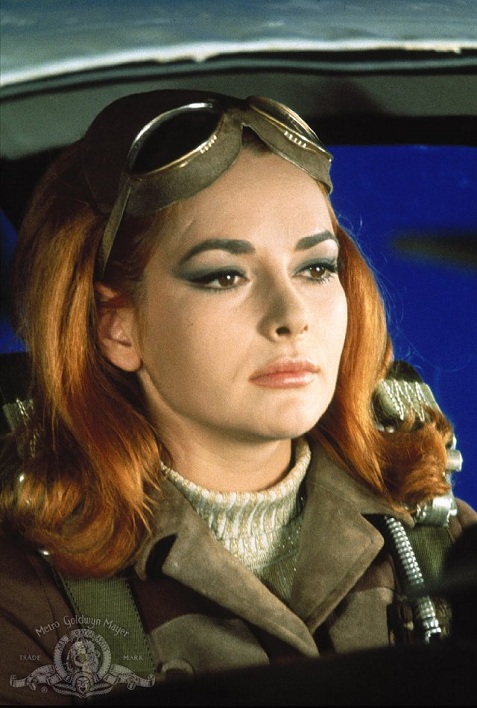
Aki (Akiko Wakabayashi) — The lovely Aki at first appears to be an enemy agent, but quickly turns out to be an able helper and a willing Bond sex partner, until her untimely end. Actress Akiko Wakabayashi is known to genre geeks around the world and not just for “You Only Live Twice.” Monster mavens know her for appearances in two films by “Godzilla” co-creator Ishirō Honda: “Ghidorah, the Three-Headed Monster” and “King Kong vs. Godzilla.” The name of the lead character was changed from Suki to Aki at her request.
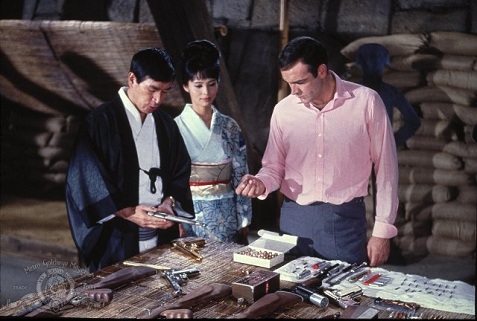
Kissy Suzuki (Mie Hama) — Unusually virtuous by Bond girl standards, Kissy never actually gets to home plate with Bond, at least not during the actual movie. Nevertheless, this student of Japanese spy chief Tiger Tanaka proves an able aid to Bond, assisting in his not-so-believable transformation into a Japanese peasant and in foiling SPECTRE’s evil plans.
Actress Mie Hama was originally assigned to play Aki/Suki and was nearly let go from the project because of her difficulties learning English. As the story goes, Hama suggested the shame of being fired might force her to commit ritual suicide and the producers buckled. Her part, like that of nearly every other foreign player in an early Bond film, was eventually dubbed by another performer. Other roles include appearing alongside Akiko Wakabayashi in “King Kong vs. Godzilla.” She also made waves by promoting “You Only Live Twice” via a nude appearance in Playboy.

Friends and colleagues
Dikko Henderson (Charles Gray) — The avuncular, kimono-clad representative of MI6 in Japan only lives long enough to get Bond’s most famous cocktail preference wrong. The late actor, Charles Gray, was a wonderfully distinctive presence in well over 120 films and television productions. Today he is mainly remembered as the narrating “no neck” Criminologist who taught the world to dance the Time Warp in “The Rocky Horror Picture Show” — a film musical he claimed to have never seen. Gray would also have the rare distinction of being killed by SPECTRE and later heading it. He would return to the Bond series as none other than Ernst Stavro Blofeld in “Diamonds are Forever.”
Tiger Tanaka (Tetsurō Tamba) — Bond makes a new friend who, for a change, survives the film. It makes sense as the bold but crafty head of Japanese intelligence has a personal subway train and routinely forces guests to arrive via trap door as a precaution. Actor Tetsurō Tamba was a venerable presence in sixties Japanese cinema and had also worked in England, making him a natural leader among the Japanese cast. With 242 credits listed on IMDb, he has appeared in a number of films well known to Western cinephiles and cultists including “Pigs and Battleships,” “Harakiri,” and the notoriously gory and campy 1991 midnight-show staple, “Riki-Oh: The Story of Ricky.” Also noted for his work as a spiritual teacher, Tamba passed on in 2006.
Moneypenny (Lois Maxwell) and M (Bernard Lee) — Bond’s unimpressed boss and his partner in flirtatious byplay return, this time dressed in full UK navel regalia. The comic business aboard one of her majesty’s atomic submarines is spry but brief, though they make an unusual appearance in the film’s final scene. Moneypenny/Lois Maxwell, we should say, looks adorable in uniform. We understand, however, that her hairstyle was thoroughly non-regulation for the English navy. Shocking.
Q (Desmond Llewelyn) — With gadgetry now a major part of the series, an appearance by the irascible armorer is now mandatory. This time, the perpetually annoyed Q finds himself forced to trudge to Japan to deliver “Little Nellie” — a thoroughly souped-up and tricked out autogyro. If Desmond Llewelyn’s irritation seems believable, it might have helped that the actor disagreed with director Lewis Gilbert’s costuming choices. Japan might be a warm country, but Llewelyn wasn’t thrilled with the military-style shirt and shorts he was given to wear. He didn’t think the very proper Q would permit himself to wear anything other than his standard business attire
The Nemesis
Ernst Stavro Blofeld (Donald Pleasence) — After being teased for years, the face of Bond’s most intractable enemy finally appears onscreen in “You Only Live Twice.” He is, of course, as diabolical and likely to feed an underperforming employee to carnivorous pets as ever. Sporting Blofeld’s trademark white Persian cat and a nasty scar on his right eye, the great character actor Donald Pleasence was already familiar to movie fans for hits like “The Great Escape” and “Fantastic Voyage.” He went on to even greater recognizability to horror fans for his portrayal of the heroic Dr. Sam Loomis in the “Halloween” series of slasher films. By the time of his death in 1996, Pleasence had racked up well over 200 film and television credits.
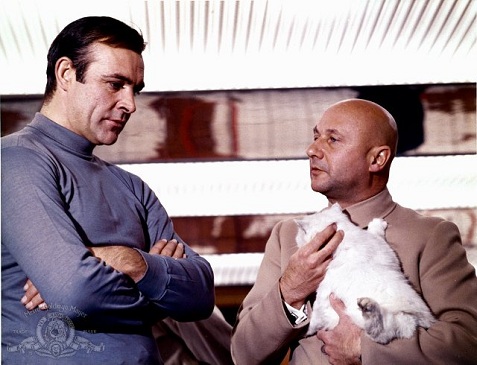
Lesser Bond Baddies
Assuming they aren’t personally killed by Mr. Bond, the hench people in “You Only Live Twice” have somewhat greater longevity than they did in “Thunderball.” Still, SPECTRE’s personnel practices remain below industry standard.
Mr. Osato (Teru Shimada) — Helga Brandt’s industrialist SPECTRE employer tries to have James Bond killed innumerable times, with predictable results. He manages to avoid the pet piranas that finally get Miss Brandt, but he still winds up getting a surprise bullet in the chest from Blofeld. Japanese-American actor Teru Shimada had recently appeared in 1966’s “Walk Don’t Run” with Cary Grant, but was actually nearing the end of a decades long career that began in the early 1930s.
Hans (Ronald Rich) — Blofeld’s gigantic body guard is repaid for his loyalty and diligence by being allowed to live long enough to get killed during the final battle. English actor Rich’s career appears to be a short one, but TV geeks should note that he did appear as the giant alien Trantis in the 1965 season of “Dr. Who” and in various roles in the 1968 run of “Benny Hill.”
SPECTRE #3 and #4 (Burt Kwouk and Michael Chow) – It would be easy to ignore these two very minor characters if it weren’t for the interesting guys playing them. You may remember that Burt Kwouk, the very talented performer who brilliantly portrayed manservant Kato opposite Peter Sellers as Inspector Clouseau, also appeared in a similar, slightly larger, role in “Goldfinger.” As for Shanghai-born character actor and citizen of the world Michael Chow, he is best known in the West as a classy restaurateur. The first Mr. Chow location opened in London in 1968, followed by editions in Beverly Hills, New York City and, eventually, Miami and Las Vegas.
License to kill
Bond’s career in extra-judicial killings of often disarmed enemies began with the unlucky Prof. Dent in “Dr. No,” but it reaches a new high here. Admittedly, there are several moments where the morality of the situation might be vague — or where we’re not sure whether Bond has actually killed an assailant or merely subdued him. Bond very definitely instantly slays the killer of his MI6 contact, Dikko Henderson (Charles Gray), however. True, the man’s act was cowardly but, morals and legality aside, it might have made more sense to keep the assassin alive and find out what was up. He also immediately dispatches both Aki’s poisoner — before he even knows what the intruder is up to — as well as the quickly disarmed would-be assassin who assaults him with a bo (a Japanese quarterstaff) in the ninja dojo.
The gadgets
Production designer Ken Adam, efx man John Stears, and the whole EON team attempt to create an airborne companion to Bond’s Aston-Martin with “Little Nellie,” a tricked up autogyro that’s a sort of cross between a helicopter and a toy plane. The film version is equipped with enough armory to take out a banana republic with machine guns, flamethrowers, and missiles. Minus the fancy weaponry, it was the very real and serious creation of designer Ken Wallis, a retired RAF pilot.
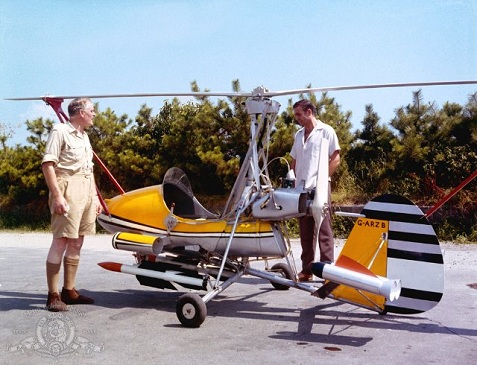
Many other gadgets are so casually integrated into the “You Only Live Twice” storyline you might almost miss them. Below are some of our favorites.
* Ninja cigarettes that eject bullet-like projectiles.
* The water-proof sarcophagus used to stage Bond’s “burial” at sea
* The “Bird 1” ship, with a front opening used to capture U.S. and Soviet spacecraft.
* Trap doors that both Blofeld and Tiger Tanaka use to create unwelcome surprises for coworkers.
* A giant magnet on a helicopter deployed by the Japanese to pick up a car filled with SPECTRE henchman and drop it in the nearby Pacific. (Since it seems unlikely the occupants could have lived, we wonder if Japanese secret services also have something like Double-O authority.)
* Mr. Osato’s spiffy X-ray desk for spotting concealed weapons.
* A pocket safecracking doodad which would come in handy if Bond ever decided to go full time to the wrong side of the law.
Note: Both the Murphy bed used in Bond’s fake assassination and Tiger Tanaka’s personal subway are sometimes considered Bond gadgets. However, since both were examples of what was very common mid-sixties technology, we don’t think they qualify as Bondian gadgetry any more than would a blender or an electric can opener.
The exotic locales
With the exception of the opening, just about all of “You Only Live Twice” takes place in Japan and the film’s exteriors were shot largely in the then-emerging economic powerhouse. Producers Cubby Broccoli and Harry Saltzman, director Lewis Gilbert, and cinematographer Freddie Young spent considerable time scouting Japanese locations. Their work paid off both in terms of visuals and, at least in the aforementioned case of the dormant volcano which became Blofeld’s lair, story ideas.
The outrageous villains’ lairs and good guy haunts
With the Bond films established as a series of reliable blockbusters, resident production design genius Ken Adam was allowed to go to town with a series of extraordinary sets, which meant more work and frayed nerves than ever. Adam has said that he and his staff were all but “living on valium” during the production of the film.
The most overtly spectacular set was obviously SPECTRE’s volcano-based super-bunker. Featuring a crater lake on top as camouflage, a rocket launch pad, and an internal light rail system, the Pinewood Studios set was very possibly the largest interior built for a film up to that point and one of the most expensive at $1 million. Ken Adam reportedly bragged that more steel was used in the set’s construction than in the London Hilton.
A more modest Adam classic is the lattice-work dome in which hot-headed U.S. and Soviets are persuaded to put off worldwide thermonuclear war while the intelligence boys at MI6 do their work. The design seems to have been influenced by R. Bunkminster Fuller’s then trendy geodesic domes.
Moving on, we’re also impressed by the apartment of the short-lived MI6 contact, Henderson. It’s a cheerful mix of British and Japanese design cliches. Tiger Tanaka’s underground office is, however, more up to the minute. Clearly, the EON team had noticed Japan’s increasing fascination with futuristic technology which was fueling the nation’s post-war economic renaissance. Similarly, the offices of bad guy Mr. Osato are an angular, half-insane variation on an ultra-modern mid-sixties interior.
The Opening
The “You Only Live Twice” pre-credit sequence is a departure from the “Goldfinger” and “Thunderball” openings in that it is not actually a Bond mini-adventure. Instead, it’s a more complicated variation on the opening of “From Russia with Love”; it’s primarily a prologue designed to set up the story and tease us with another fake Bond death. Bond doesn’t even try to kill anyone. (He’ll make up for that later.)
We begin in outer space as a mysterious vehicle snatches an American space capsule, murdering an astronaut in the process. Next, we are in some kind of super-high level diplomatic meeting room in which the calm, thoughtful British must mediate between jingoistic Americans and nasty Soviets to avoid a rush to global thermonuclear war. Finally, we are in a garish Hong Kong boudoir as Bond has finished making love with the seemingly treacherous Ling (Tsai Chow). She traps Bond in a Murphy bed, where he meets an apparent quick end at the hands of machine gun wielding thugs. Afterwards, a police officer who appears to have known Bond philosophizes that, at least, Bond met his demise “on the job.”
A close-up of a shot of (presumably fake) blood fades out into an animated design reminiscent of a Japanese umbrella and we’re off for another striking credit sequence by Maurice Binder. As the lyrical title song plays, we are given Japanese-inspired abstract designs, shots of lava flowing inside a volcano, and the usual female silhouettes. Once again, we are being promised adventure, a bit of tasteless exoticism, violence and, naturally, sex, sex, sex.
The Music
By now, it was a foregone conclusion that composer John Barry would provide both the score and the title song. Barry’s “Goldfinger” lyrical collaborator, show tune specialist Leslie Bricusse, returns for one of the better songs in the Bond cannon. Barry seems to have decided to abandon the brassiness of “Goldfinger” and “Thunderball” for a more romantic tune along the lines of “From Russia with Love,” only better.
Nancy Sinatra and her famous father, Frank, were friends of the EON team. So, it was only natural that she was brought on to perform the song, even though an earlier version had already been recorded by English singer Shirley Rodgers. The only difficulty was that the younger Sinatra, whose recent recording of “These Boots Were Made for Walking” had been a monster hit, was much more a rock and roll singer than a polished classic pop chanteuse. As Nancy Sinatra herself tells it, it took countless takes and a lot of editing to produce the sexy and charmingly wistful “You Only Live Twice” title track.
As for the instrumental score, composer Barry adds a bit of Japanese beauty to the mix, but it was the cosmos that inspired the most influential work. The haunting and majestic “Capsules in Space” is a definite influence on John Williams’ music for “Star Wars.”
Action Highlights
“You Only Live Twice” was instrumental in popularizing Asian martial arts in Western films and also for establishing ninjas as go-to pop culture badasses. The final battle, in which hundreds of ninjutsu-trained operatives invade Blofeld’s mega-lair, is certainly among the most spectacular fight scenes in the 007 cannon. It’s also probably responsible for a number of increasingly elaborate, you might even say overblown, Bond finales to follow.
An arguably even more thrilling set-piece, however comes much earlier in the film as Bond and Aki are pursued at the Kobe docks by a number of local SPECTRE henchmen. In a bold move, director Lewis Gilbert and camera-great Freddie Francis film part of the fight via a thrilling aerial shot of the ongoing action. Speaking of aerial shots, the airborne battle in which Bond and Little Nellie fend off “improper advances” from four machine-gun equipped aerial helicopters is an enjoyable blend of exciting aerial footage and back projection close-ups.
For those who enjoy a bit more hand-to-hand combat, we’re somewhat fond of a relatively brief but delightfully brutal fight between Bond and a sword wielding opponent, portrayed by uncredited Samoan-American pro-wrestler and fight choreographer Peter Fanene Mavia. Mavia, who unfortunately passed on at age 45, is today best remembered as the grandfather of wrestler-turned-action star Dwayne “the Rock” Johnson.
The ninja camp training sequence is also an enjoyable spin on the “Spartacus”-inspired SPECTRE training camp in “From Russia With Love.” It was probably the first time a truly gigantic Western audience was exposed to Asian martial arts in a major motion picture. It also contains a surprisingly faithful homage to the fight scenes in the Japanese samurai films that were then being discovered in art houses throughout America and Europe.
The one-liners
James Bond (Prior to making love to the evil Helga Brandt): The things I do for England!
Hong Kong Policeman #2: [finding the fake-deceased Bond in Ling’s Hong Kong boudoir] At least he died on the job… he would have wanted it that way.
Kissy Suzuki: No honeymoon. This is business.
James Bond: [pushing aside a plate of oysters] Well, I won’t need these.
Mr. Osato: You should give up smoking. Cigarettes are very bad for your chest.
Helga Brandt: Mr. Osato believes in a healthy chest.
James Bond (observing Brandt’s upper torso): Really?
Tiger Tanaka (showing Bond a projectile equipped cigarette): It can save your life, this cigarette.
James Bond: You sound like a commercial.
James Bond: Well, if I’m going to be forced to watch television, may I smoke?
Blofeld: Yes. Give him his cigarettes. It won’t be the nicotine that kills you, Mr. Bond.
James Bond (having just dispatched an adversary into Blofeld’s piranha-infested indoor pool): Bon appetit!
Tiger Tanaka: You know what it is about you that fascinates them, don’t you? It’s the hair on your chest. Japanese men all have beautiful bare skin.
James Bond: Japanese proverb say, “Bird never make nest in bare tree.”
[About to have his chest hair waxed so he can pass for Japanese]
James Bond: Why don’t you just dye the parts that show?
James Bond (greeting Q, who has brought Little Nellie to Japan): Welcome to Japan, Dad. Is my little girl hot and ready?
Q: Look, 007, I’ve had a long and tiring journey, probably to no purpose, so I’m in no mood for juvenile quips.
Cocktails and other beverages
Bond’s drinking is more under control than usual here, though the super spy gets to show his knowledge of the finer points of Japan’s native beverage, the rice wine known as saki. It’s usually served warm — 98.4 degrees Fahrenheit, he reminds us. Bond seems considerably less enthralled with some Siamese vodka. Most famously, 007 politely endures confusion regarding his cocktail preferences by the soon-to-be-slain Dikko Henderson. The MI6 man offers him a vodka martini “stirred, not shaken,” in an incorrect Tom Collins glass, which Bond accepts without complaint. At another point, he is tempted into some morning drinking by a bottle of Dom Perignon 1959.
Random facts
* There are a number of jokes about cigarettes and cigarette smoking in “You Only Live Twice.” Considering the historic U.S. Surgeon General’s Report definitively naming smoking as a serious health risk had only come out in 1964, the same year heavy smoker and drinker Ian Fleming had died at age 56 of a heart attack, it was a highly topical subject. (To this day, you will find more smokers on film sets than elsewhere.)
* Donald Pleasence was actually a last-minute replacement as the first fully on-screen Blofeld. Czech actor Jan Werich was originally cast in the role and shot a few days worth of scrapped footage. The EON team decided that the bearded thespian’s grandfatherly appearance was too benign for the ultra-ruthless super villain.
* For whatever reason, Ernst Stavro Blofeld would, from this point on, be played by different actors with radically different looks in each film. Future Blofelds would include the relatively hulking “Kojak”-to-be Telly Savalas in “On Her Majesty’s Secret Service,” who at least was as bald as the somewhat diminutive Donald Pleasence had been in the role. Blofeld would miraculously sport a full head of hair, however, when he was played by the aforementioned Charles Gray in 1971’s “Diamonds are Forever.”
* Donald Pleasence’s appearance and manner as Blofeld is pretty obviously the primary inspiration for Mike Myers’s Dr. Evil in the Austin Powers series. (Evil’s speaking voice is just as obviously inspired by “Saturday Night Live” producer Lorne Michaels.)
* Fans trying to put together a complete biography of Bond have made much of the ever humble 007’s reminder to Moneypenny that, “You forget, I took a first in Oriental languages at Cambridge.” This is a contradiction with the novels, where Bond was ejected from Eton College for an unsurprising infraction with female cleaning personnel and had to finish his education in Scotland.
* “You Only Live Twice” is actually the second time that Sean Connery, as a pre-coital Bond said, “The things I do for England!” The line was also shot during the filming of “Thunderball.” It made it into that film’s promotional material but was cut from the actual movie. Being too good a line to waste, it was re-used and included here.
* Ironically, screenwriter Roald Dahl’s World War II intelligence experiences were in some ways more Bondian than those of Ian Fleming. It was, in fact, his youthful gift for starting affairs with prominent women that seems to have attracted the attention of British spies working in North America trying to draw the United States into the war prior to Pearl Harbor. His most famous conquest in England’s service was playwright and conservative Republican politician Clare Booth Luce, the wife of the founder of Time magazine.
* When Mie Hama was unable to swim for her scenes, she was doubled by Australian actress Diane Cilento, an able swimmer who was married to Sean Connery at the time. Cilento, who passed on in 2011, is probably now best known for her supporting role in the 1974 cult classic, “The Wicker Man.” She also appeared in such notable 1960s features as “Tom Jones,” “The Agony and the Ecstasy,” and “Hombre.”
* Some have mistakenly said that the title, “You Only Live Twice” comes from a poem by Basho, Japan’s most famous poet. It’s actually from a not-quite haiku Bond attempts to compose in Basho’s style in Ian Fleming’s novel.
“You only live twice
Once when you’re born
And once when you look death in the face.”
Leslie Bricusse’s lyrics for the song, “You Only Live Twice,” equate the second life to falling in love. Much more romantic.
* By all accounts, Sean Connery and Diane Cilento had a pretty miserable time making “You Only Live Twice.” Spy mania and an aggressive Japanese press in particular seems to been a huge problem for the star and his bride. By the time “You Only Live Twice” was released, Connery had made it public that he would cease playing Bond. It turned out to be the first of three times that would happen.
The Romantic Ending
“You Only Live Twice” is, we think, the only Bond entry where the main romance seems to have gone not much further than passionate necking. Kissy abandons her resistance to Bond by the end of the film, but they are interrupted by an inopportune submarine and Moneypenny seems only to anxious to cut off any more funny business. All the more tragic as it looks like Bond and Kissy might not be allowed to see each other again.
“James Bond Will Return”
“The end of You Only Live Twice but James Bond will be back On Her Majesty’s Secret Service” read the final titles this time around. A similar credit was originally included at the end of “Thunderball” and later removed. In fact, James Bond did come back, but he would be George Lazenby.
Related Posts
You can follow us on Twitter and Facebook for content updates. Also, sign up for our email list for weekly updates and check us out on Google+ as well.
Posted in: Entertainment, Movies
Tags: 007, 007 50th anniversary, 007 films, 007 gadgets, 007 guns, 007 movies, 007 One by One, 007 villains, Aki, Akiko Wakabayashi, beautiful Bond women, Bernard Lee, best Bond movie moments, Bond babes, Bond films, Bond gadgets, Bond girls, Bond movies, Bond one by one, Bond villains, Burt Kwouk, Charles Gray, classic Bond gadgets, Desmond Llewelyn, Dikko Henderson, Donald Pleasence, Dr. Evil, Ernst Stavro Blofeld, Freddie Young, Hans, Helga Brandt, helicopter, iconic James Bond moments, James Bond, James Bond 007, James Bond 50th anniversary, James Bond actresses, James Bond babes, James Bond blog, James Bond craze, James Bond drinks, James Bond franchise, James Bond girls, James Bond guns, James Bond henchmen, James Bond movies, James Bond music, James Bond nemesis, James Bond villains, James Bond violence, John Barry, Karen Dor, Ken Adam, Kissy Suzuki, Lewis Gilbert, license to kill, Ling, Little Nellie, Lois Maxwell, M Bond, Maurice Binder, memorable Bond scenes, Michael Chow, Mie Hama, Moneypenny, Mr. Osato, Nancy Sinatra, Ninja cigarettes, Q Bond, Roald Dahl, Ronald Rich, Sean Connery, SPECTRE, SPECTRE #3, SPECTRE #4, supervillains, Teru Shimada, Tetsurō Tamba, Tiger Tanaka, Tsai Chow, villain's lair, Walther PPK, water-proof sarcophagus, You Only Live Twice




